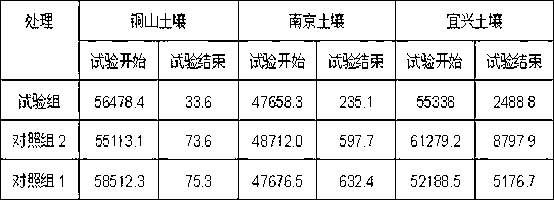Method for preventing soil-borne diseases of crops by using ammonium-reinforced biogas slurry
A technology for soil-borne diseases and crops, applied in the field of preventing and controlling soil-borne diseases of crops, can solve the problems of ineffective utilization, unreasonable use of water and fertilizer, and obstacles to continuous soil cropping, so as to reduce the incidence of soil-borne diseases and promote the recycling of resources. , the effect of shortened processing time
- Summary
- Abstract
- Description
- Claims
- Application Information
AI Technical Summary
Problems solved by technology
Method used
Image
Examples
Embodiment 1
[0018] Preparation of Ammonium Enhanced Biogas Slurry
[0019] The raw material for fermentation is pig manure, collected from a pig farm near Jiangsu Academy of Agricultural Sciences. The inoculum sludge is the digested liquid of anaerobic fermentation of pig manure in our research laboratory. Under the condition of medium temperature [(37±2)℃], the anaerobic fermentation test was carried out in a continuous flow stirred reactor (CSTR). In the CSTR reactor Inoculate the sludge, and finally adjust with water to make the total solids content load 4.0%, pass nitrogen gas for 15 minutes to remove the air in the tank, and seal it. After fully fermenting for 28 days, the fermented liquid is released and introduced into a circular biogas slurry storage tank with a diameter of 3.5m and a depth of 1.2m. The main physical and chemical conditions of the original biogas slurry are shown in Table 1. According to the measured ammonium nitrogen concentration of the original biogas slurry,...
Embodiment 2
[0023] Inhibitory effect of ammonium-enhanced biogas slurry on the growth of Phytophthora capsici
[0024] The pathogenic fungus Phytophthora capsici was isolated from the rhizosphere soil of pepper root rot diseased plants, and was preserved by the Agricultural Waste Recycling Engineering Technology Research Center of the Institute of Environmental Protection, Jiangsu Academy of Agricultural Sciences. Phytophthora was inoculated into a PDA plate, cultured at 28-30° C. for 5 days, and then punched with a hole punch to obtain mycelial blocks with a diameter of 4 mm for use.
[0025] Preparation method of Phytophthora zoospore suspension: Phytophthora capsici was cultured in V8 medium for 5 days, and 20 hyphae blocks (Φ6 mm) from the edge of the colony were punched and put into a petri dish filled with 15 ml of sterile water. The side with mycelium was facing up, the liquid surface submerged the mycelium block, and the light and dark were alternately cultured (12 h / 12 h) for 2...
Embodiment 3
[0031] Inhibitory effect of biogas slurry on plate growth of two pathogens of strawberry.
[0032] Test method: plate mycelial growth inhibition method: mix 5ml of ammonium-enhanced biogas slurry or sterile water or fresh biogas slurry with 45ml of dissolved PDA medium at 50-60°C and pour it on the plate, and inoculate a diameter of 1 in the center of the plate after solidification 6 mm of pathogenic fungus hyphae, cultured at 28°C, measured the colony diameter of Solitaire blight after 72 hours, and measured the colony diameter of Fusarium wilt after 120 hours, with 5 replicates for each treatment.
[0033] The test group was ammonium-enhanced biogas slurry, that is, mixed with 5ml of ammonium-enhanced biogas slurry and dissolved 50-60°C PDA medium and poured on the plate; control 1 was a blank control, that is, mixed with 5ml sterile water and dissolved 50-60°C PDA medium PDA medium was mixed and poured on the plate; control 2 was mixed with 5ml of fresh biogas slurry and di...
PUM
| Property | Measurement | Unit |
|---|---|---|
| diameter | aaaaa | aaaaa |
| depth | aaaaa | aaaaa |
| diameter | aaaaa | aaaaa |
Abstract
Description
Claims
Application Information
 Login to View More
Login to View More - R&D
- Intellectual Property
- Life Sciences
- Materials
- Tech Scout
- Unparalleled Data Quality
- Higher Quality Content
- 60% Fewer Hallucinations
Browse by: Latest US Patents, China's latest patents, Technical Efficacy Thesaurus, Application Domain, Technology Topic, Popular Technical Reports.
© 2025 PatSnap. All rights reserved.Legal|Privacy policy|Modern Slavery Act Transparency Statement|Sitemap|About US| Contact US: help@patsnap.com



